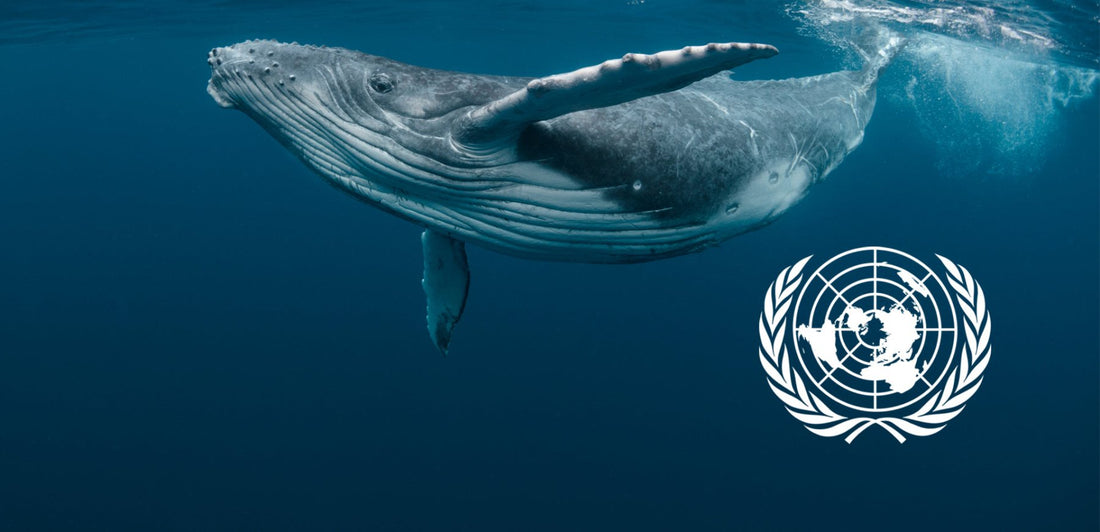TWOTHIRDS is calling for every country to sign the UN High Seas Treaty, to protect what we love most: our ocean.
Did you know that history was made on September 20th as nation-states signed on the dotted line to protect international waters from exploitation? In a world awash with bad news, the UN High Seas Treaty was a glimmer of hope, showing that there is an appetite for people and governments to unite and protect the environment.
With the minimum of 60 nation signatures already met (82 at the time of writing), the treaty is now guaranteed to be ratified, but the more countries that sign up, the more effective the treaty will be.
“We need to keep working towards a swift ratification, with the hope that the treaty can enter into force by the June 2025 UN Ocean Conference in Nice, France.” - UN Commissioner for Environment, Oceans and Fisheries Virginijus Sinkevičius
What Are The High Seas & International Waters?
The UN defines the high seas as those areas of ocean which do not fall under national jurisdiction. Prior to the drafting of the treaty, this vast tract of ocean, which constitutes an incredible half of the Earth’s surface and 95% of the ocean’s volume, was free game – open to unchecked exploitation.

Imagine a piece of land that covers half of the planet’s surface being designated as a protected national park and that gives some context as to just how remarkable this agreement is, although it should be noted that the treaty only provides a framework for the creation of future marine conservation areas within the high seas, and does not offer an instant, blanket environmental protection.
How Will The Treaty Protect The Ocean & Who Will Enforce It?
The UN will not be sending ocean-bound UN peacekeepers to protect the high seas. Instead, the treaty provides a framework through which international law can be leveraged to force state and private actors to treat international waters respectfully; in a way that takes into account all stakeholders – whales included!

Which Countries Have Signed & Which Are Still To Sign?
The list of signatories can be found here. Among them are our home country Spain, as well as global powerhouses such as China and the US. The EU has also played a significant role in bringing this treaty to fruition by encouraging all its member states to sign up.
At the time of writing, some countries notably absent from the treaty include Canada, Russia and Japan. Both Canada and Russia would be particularly crucial signatories considering they have the 1st and 4th largest coastlines in the world respectively, with both nations keen to exploit natural resources that will become available as Arctic sea ice melts.
Does The Treaty Go Far Enough?
There are well-founded concerns that, despite all its positive implications, the UN High Seas Treaty may fall short of providing adequate protections to the ocean. The most pertinent of these are well summarised in the Nature journal:
“...the treaty’s provisions don’t overrule regulations laid down by the authorities that oversee existing high seas activities.”
- This means that any mining, fishing or shipping projects that have already been okayed by bodies like the International Maritime Organisation won’t be prohibited by the treaty, so much of the high seas will still be open to exploitation through regulatory back channels.
“The treaty cannot create protected areas in places already covered by fishing agreements, even if that fishing is unsustainable and depleting stocks.”
- One of the treaty’s biggest oversights, it will be hard for many areas of the high seas to be rewilded and for fish populations to be replenished. As well as existing fishing operations, military operations will also be exempt from the treaty’s oversight, an oft overlooked source of marine habitat disruption.

“Nor will the treaty end current offshore environmental violations.”
- Cruise ships will still be free to pump waste into the high seas, agricultural and industrial chemicals will still create ocean dead zones, and the amount of plastic in our ocean will continue to grow, because the treaty does not have the scope to penalise such environmental violations.
Why The Treaty Is Still A Huge Win!
No international agreement is ever water tight (excuse the pun!). There are always compromises to be made. By and large, this is still a treaty very much worth supporting as it will empower nations and peoples to create protected areas of the high seas, which international law and the UN will then help them uphold.

Other excellent aspects of the treaty include its acceptance that richer nations should bear the brunt of the costs related to ocean conservation. This will be made possible by a stakeholder ownership-style structure, whereby countries can profit from exploiting resources found in the high seas, but only so long as they channel a percentage of their profits into a fund dedicated to protecting the ocean. Richer countries will also be asked to pay a higher percentage of profits than their poorer counterparts.
There will also be scope for all scientific research findings related to the high seas to be made open-source (available to the public) so that smaller countries can benefit from such data without incurring the usual high costs. This will help prevent powerful state and private entities taking advantage of poor countries that lack the crucial data they need to develop policies that protect their local ecosystems.
In short, the UN High Seas Treaty may not be perfect, but it’s a giant step in the right direction.
Write to your political representatives today and get them onboard!








